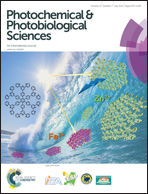“Turn-on” fluorescent chemosensor for zinc(ii) dipodal ratiometric receptor: application in live cell imaging†
Abstract
A dipodal ligand 2,2′-((ethane-1,2-diylbis(azanediyl))bis(ethane-1,1-diyl))diphenol was synthesized through a condensation reaction and was characterized with IR, 1H NMR, 13C-NMR, and mass spectroscopy. The receptor 2 has shown marked enhancement in fluorescence intensity (emission signal at 341 nm) on binding with Zn2+ as compared to other surveyed metal ions. The sensor has shown dramatic changes in dual channel fluorescence emission with λmax at 300 and 341 nm. The successive addition of Zn2+ to the solution of the sensor led to a blue shift of the peak maxima and interestingly upon addition of higher equivalents of Zn2+ quenched the fluorescence intensity of the sensor, and ultimately the original fluorescent profile of sensor was restored. The structures of 2 and 3 were optimized with B3LYP/LanL2DZ basis sets. The receptor 2 successfully detect the Zn2+ ion in HeLa cells cultured in Zn2+ enriched medium.


 Please wait while we load your content...
Please wait while we load your content...